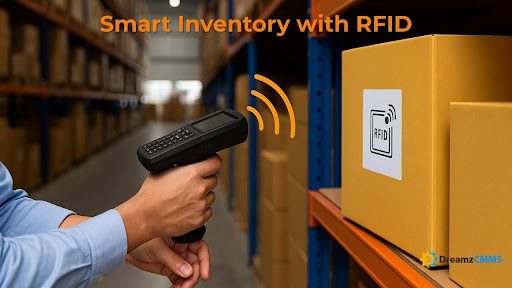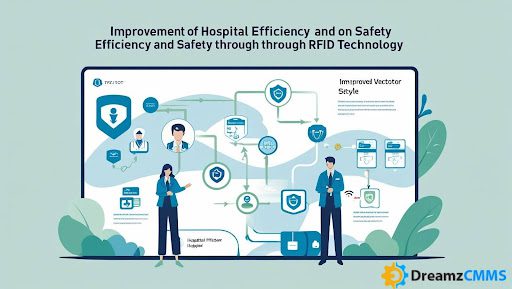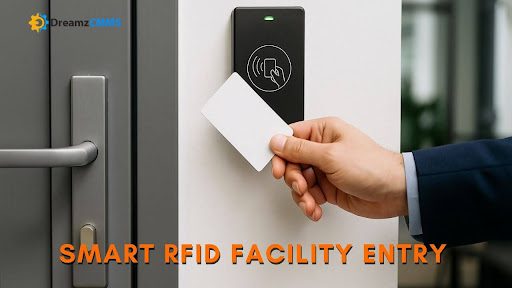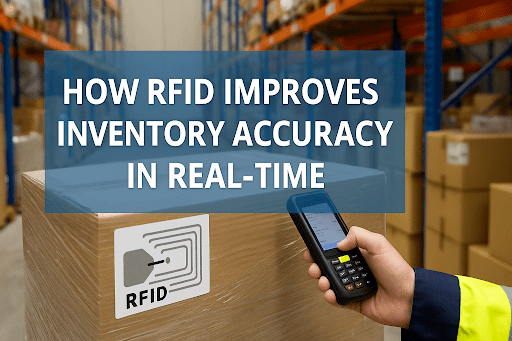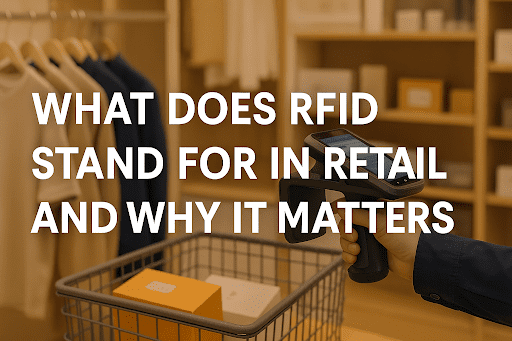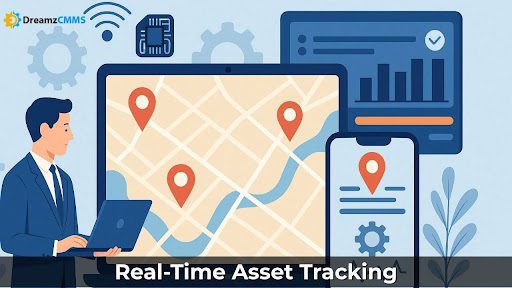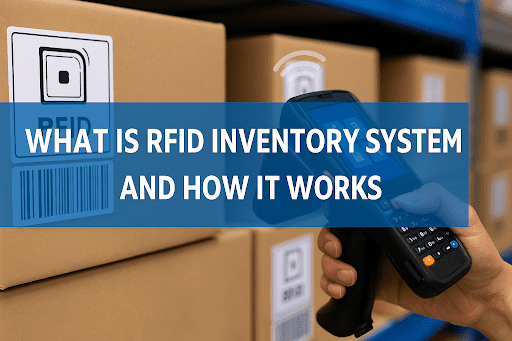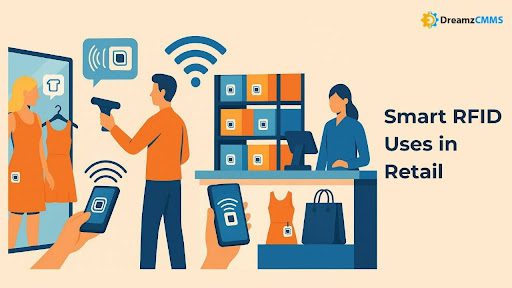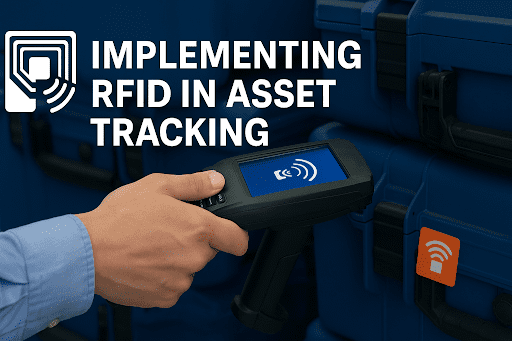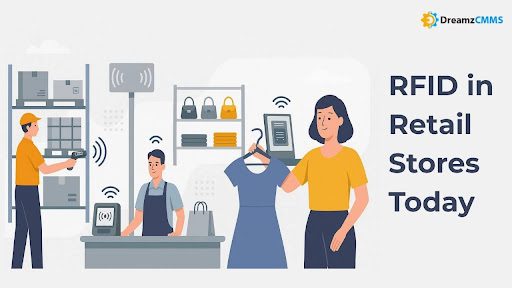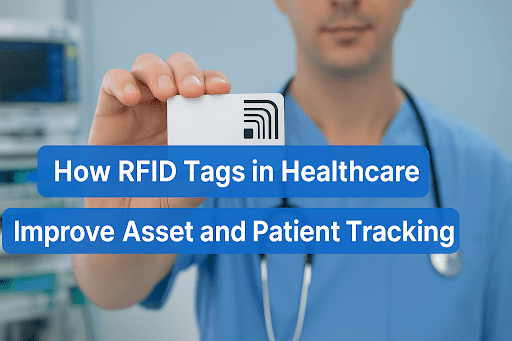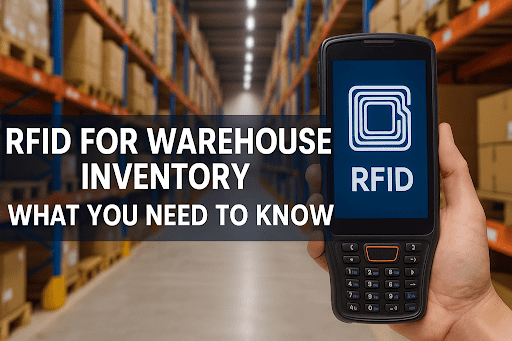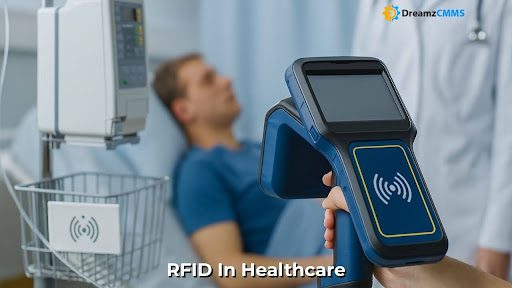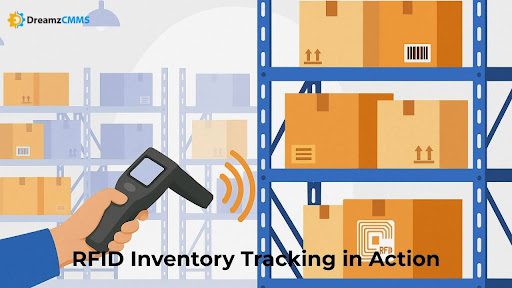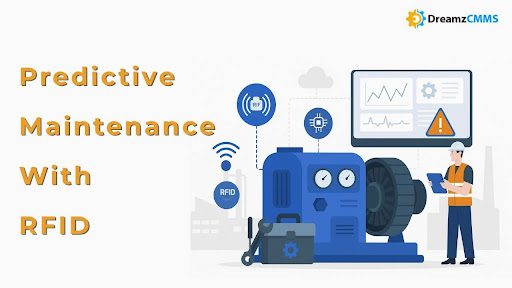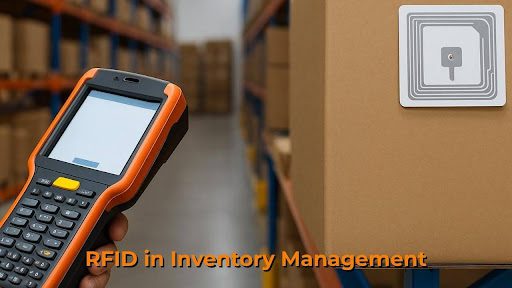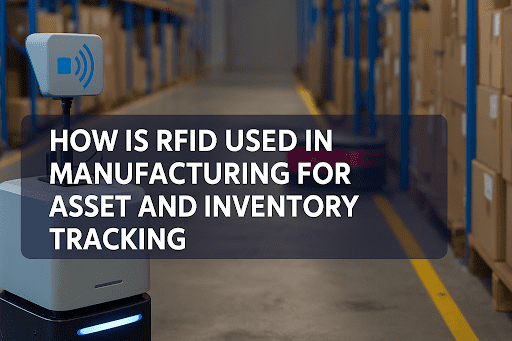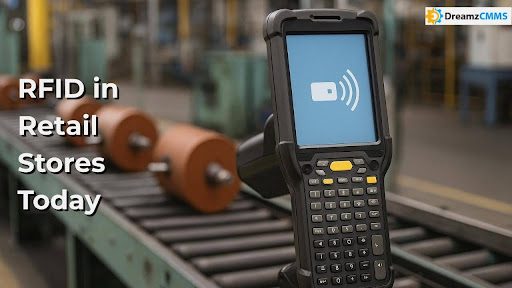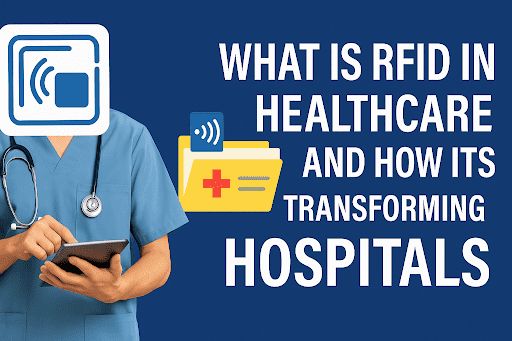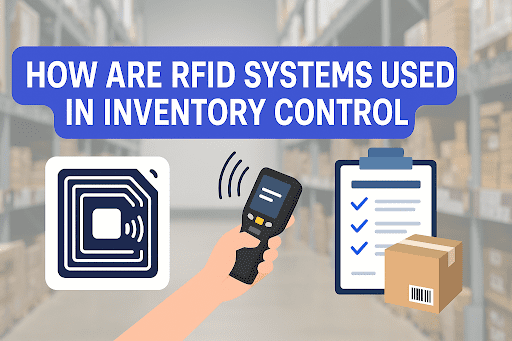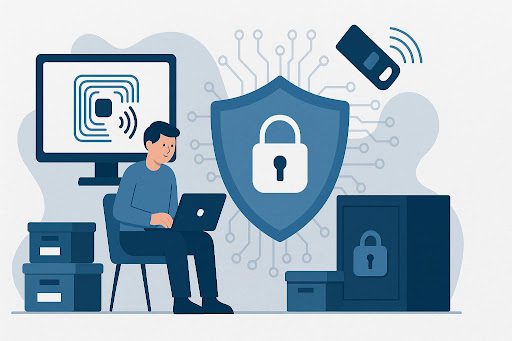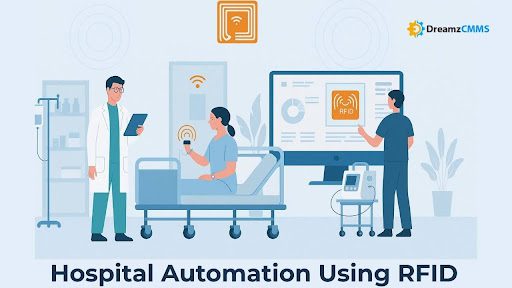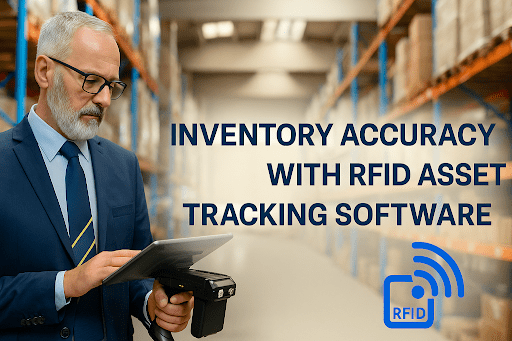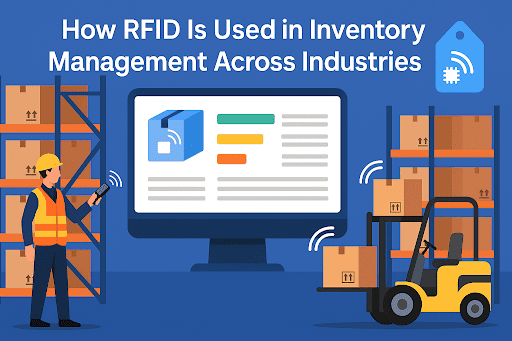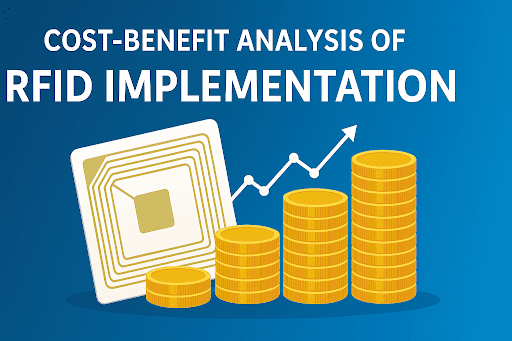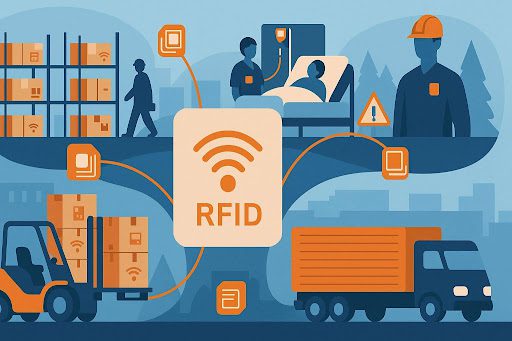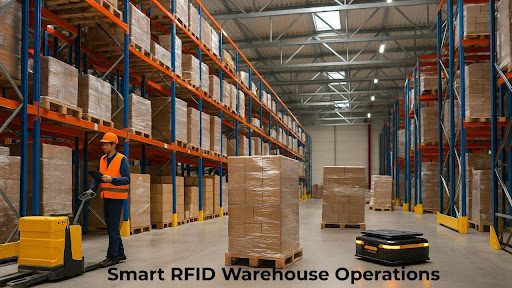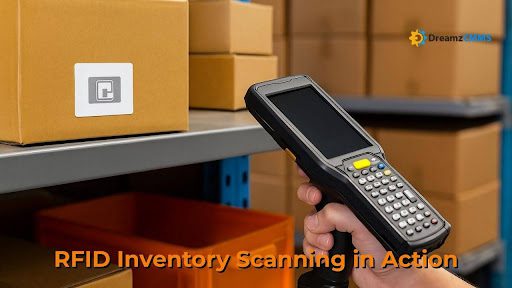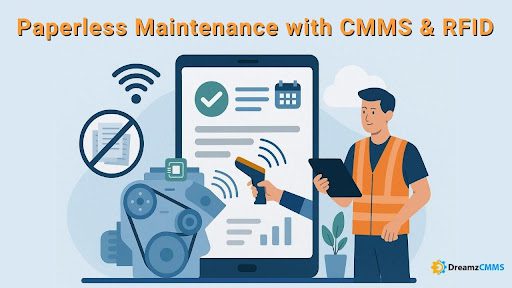 BACK TO Blog
BACK TO Blog
Asset Rental Management
RFID Asset Tracking
In modern retail competition, real-time fulfillment and operational speed are required. Because this can directly affect customer satisfaction. Retailers achieve inventory accuracy through RFID technology which also reduces stock shrinkage to deliver seamless shopping experiences. The use of RFID inventory management systems allows businesses to monitor all their supply chain
- June 20, 2025
- DreamzCMMS Team
- 10 minutes read
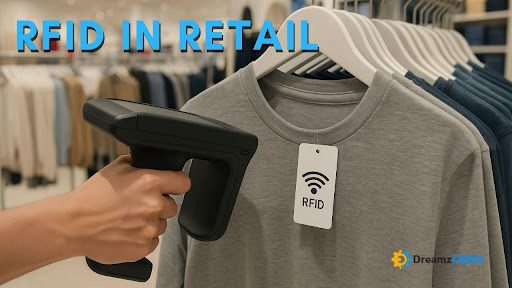
- June 20, 2025
- DreamzCMMS Team
- 10 minutes read
In modern retail competition, real-time fulfillment and operational speed are required. Because this can directly affect customer satisfaction. Retailers achieve inventory accuracy through RFID technology which also reduces stock shrinkage to deliver seamless shopping experiences.
The use of RFID inventory management systems allows businesses to monitor all their supply chain assets and store items which leads to improved response times and better control systems and decision-making capabilities. This blog explores how RFID technology optimizes retail operations through smart implementations while showing examples of real-world success stories.
Unlock Real-Time Retail Visibility with RFID
The implementation of RFID technology enables real-time inventory tracking which helps decrease shrinkage and enhance store operational efficiency. Smart asset tracking and analytics enable your retail operations to become more powerful.
RFID Asset Tracking Software
What Is RFID in Retail?
The wireless method of Radio Frequency Identification (RFID) enables object tracking through electromagnetic field communications between tagged items. RFID tags contain stored data which RFID readers can detect from any location without needing direct access to the tags.
Smart inventory systems which replace manual scanning function through RFID asset tracking for retail stores use this technology to deliver real-time visibility and automation.
Retailers use RFID for:
- In-store item tracking with RFID
- RFID-based retail loss prevention
- RFID stock replenishment solutions
- RFID-enabled point of sale systems
RFID systems consist of mainly three key components:
- RFID tags: Embedded in merchandise or packaging.
- RFID readers: Retail locations implement these devices in strategic positions for both stationary use and mobile operation.
- Backend software: The backend software integrates with inventory systems as well as POS and ERP platforms for obtaining real-time insights.
The complete operation of RFID systems is explained in detail within our RFID Tracking System Guide.
Why Retailers Are Adopting RFID Rapidly
1. Real-Time Inventory Accuracy
Traditional inventory systems maintain a 65-70% accuracy level. When retailers implement RFID inventory tracking systems they achieve more than 95% real-time inventory accuracy which enhances both stock audits and sales forecasting processes.
The precise tracking enabled by RFID systems eliminates costly mistakes which include over-orders along with duplicate inventory items and untracked stockouts that reduce revenue.
RFID Asset Tracking Software enhances stock precision by using Inventory Accuracy as its main function. Inventory Accuracy with RFID Asset Tracking Software.
2. Automated Replenishment
RFID stock replenishment solutions use automatic systems that find low inventory levels to trigger backroom or warehouse notifications or automated order placements. The process of keeping shelves full with this method leads to better sales performance and customer contentment.
Advanced RFID systems use sales patterns together with promotional information and seasonal data to generate replenishment strategies.
3. Speedy Checkout with RFID
Retailers now operate point of sale systems with RFID technology which can scan multiple items instantly while needing no direct visual contact. The system provides faster operations with fewer mistakes to create an improved customer experience especially during times of high demand.
The combination of easy checkout processes along with brief waiting times and digital receipt options creates lasting brand loyalty among customers.
4. Smarter Customer Experience
The combination of RFID technology with IoT systems powers smart retail solutions which include interactive shopping features like smart fitting rooms and product suggestions and mobile-assisted navigation.
Through RFID technology stores can show live inventory counts through mobile apps and kiosks while suggesting alternative products and helping customers find items in their stores.
Key Benefits of RFID in Retail
A. Inventory Visibility Across Supply Chain
RFID tags used for retail supply chain operations offer complete tracking visibility from warehouse storage areas to retail store display floors. The system allows retailers to track their products in real time during transportation and storage operations which decreases human mistakes.
This system helps suppliers and distribution centers and stores maintain better communication which decreases delays between stock levels.
B. Reduced Theft and Shrinkage
The use of RFID-based retail loss prevention systems allows for the detection of unauthorized item movements. The RFID system integrates with security gates and EAS systems to alert staff about improper removal of tagged products.
The implementation of RFID technology leads to a 40% reduction in shrinkage for retailers thus providing an effective cost-saving solution for loss prevention.
C. Streamlined Returns and Warranty Tracking
The RFID asset tracking system for retail stores enables fast product verification during returns which allows for swift inventory integration.
This reduces manual errors in restocking, improves returns processing time, and allows warranty tracking tied to item-level data — all enhancing post-sale service.
D. Omnichannel Fulfillment Support
The use of RFID by retailers enables BOPIS (Buy Online, Pick-Up In Store), ship-from-store, and curbside pickup operations with reliable inventory data.
The agility of retail brands to serve changing customer needs across all sales channels is supported by RFID inventory management systems.
Real-World Examples: RFID in Retail Applications
1. Fashion & Apparel
Global fashion retailers implement RFID in their retail operations to track style, size and color options. Retail staff members can use RFID automated shelf scanning to decrease their stock monitoring work so they can focus more on customer interactions.
The RFID tags Uniqlo attaches to each item trigger automatic restocking alerts as well as provide real-time floor visibility.
2. Grocery Chains
Grocers implement RFID technology to monitor both expiration dates and temperature-sensitive products while minimizing food waste. RFID systems improve both supply chain operations and inventory management on store shelves.
RFID and IoT in retail enables managers to detect spoilage and cold chain disruptions thus reducing financial losses.
3. Consumer Electronics
The implementation of RFID technology in electronic retail digitization enables automated warranty data tracking alongside high-value item security measures.
Best Buy utilizes RFID technology to track customer interaction with demo items which allows them to deliver personalized post-purchase services.
RFID vs Barcode in Retail: A Comparative Table
| Feature | Barcode | RFID |
| Line-of-sight required? | Yes | No |
| Scan multiple items? | No | Yes |
| Data capacity | Limited | Rich item-level data |
| Durability | Prone to wear | Highly durable |
| Updateable? | No | Yes (for some tag types) |
| Integration with IoT | Limited | Full compatibility |
Implementing RFID in Retail Stores
1. Choosing the Right RFID Tags
RFID tags for retail supply chain vary by use. Choose based on:
- Product type and packaging material
- Reusability and durability
- Cost and integration capabilities
The tags used for clothing differ from those used for metal or liquid-sensitive products including electronics and beverages. Retailers operating extensive inventory management can optimize their tagging and service tracking needs through Asset Maintenance Management Software.
2. Infrastructure Planning
Plan for:
- Handheld RFID readers
- Overhead or doorway antennas
- Integrated POS and ERP systems
- Smart shelves and displays
RFID-based automated shelf scanning helps retailers maintain correct planogram alignment while improving visual display precision. Retailers operating multiple locations together with rental units should integrate RFID with Asset Rental Management Software to achieve unified visibility and control.
3. Software Integration
Connect RFID platforms with:
- Inventory and order management software
- CRM and POS platforms
- Mobile store apps
To extract retail trends and customer behaviors from RFID analytics data the system requires continuous data flow between components. The Facility Management Software includes RFID-enabled infrastructure which tracks both assets and energy consumption and maintenance requirements.
4. Staff Enablement
The staff needs training to handle RFID systems alongside alert analysis and system troubleshooting responsibilities. Engagement training helps organizations achieve quick returns on investment and creates more efficient workflows. Get expert tips in our blog: Implementing RFID in Asset Tracking
Challenges of Using RFID in Retail
The implementation of RFID technology provides significant benefits to retail businesses but they face multiple obstacles during the implementation process. Retailers must identify key obstacles to successful RFID deployment so they can create effective solutions to address these challenges.
Initial Investment
RFID adoption faces one primary barrier because of the high initial costs required. Businesses need to purchase RFID tags together with readers and antennas and backend software and require installation and integration services to implement the technology. Large retail businesses and enterprises with extensive inventory systems need to spend a considerable amount on their initial RFID deployment.
The implementation of RFID technology should be treated as a future-oriented business investment. The expenses incurred at first will lead businesses to achieve returns through various benefits including:
- Reduced shrinkage and theft
- Improved inventory accuracy
- Fewer labor hours spent on manual stock counts
- Faster replenishment cycles
- Enhanced customer satisfaction and repeat business
Through calculations of return on investment (ROI) from operational efficiencies and data-based decision making many retailers determine their initial costs are compensated by future financial benefits.
Product-Specific Tag Needs
RFID technology is not suitable for all products. RFID technology does not work for every product. The RFID signal transmission system experiences interference when metal and liquid products such as canned goods, electronics, cosmetics or beverages come into contact with the system. Standard RFID tags fail to deliver reliable or dependable readings in such situations.
To address this, retailers must:
- Test different placements on packaging
- Conduct environmental testing in real store or warehouse settings
- Retailers should work with RFID solution providers to develop tags that match their product assortment.
The selection of appropriate RFID tags together with field testing is necessary for achieving reliable signal transmission and system operational success across all product groups.
Integration Complexity
Another challenge lies in system integration. Most retail businesses currently operate with an intricate mix of technological systems including POS systems and ERPs and inventory management platforms and CRM software. To implement RFID successfully retailers need to plan carefully for integration because they need system compatibility and real-time synchronization along with data consistency.
System integration issues create data silos which results in inconsistent inventory records and maintenance challenges and increased IT expenses and restricted departmental visibility.
To prevent this, retailers should:
- Retailers should select RFID solutions which provide open APIs and flexible integration options
- Retailers should implement RFID as part of their strategic digital transformation plans and IT roadmaps
- Key stakeholders from IT operations and merchandising teams need to be involved in the process
- Prioritize future scalability and unified data access
RFID implementation planning should consider integration from the start to provide a system that will support ongoing retail operations and future development.
The Future of RFID in Retail
Merging RFID with AI & IoT
RFID and IoT integration in retail produces environments that function as intelligent systems because:
- Sensors detect foot traffic
- Smart shelves initiate replenishment
- Digital signage responds to customer presence
RFID analytics gain predictive abilities through AI integration which enables retail trend prediction for proactive merchandising and forecasting.
Towards Sustainability
The use of RFID promotes environmental responsibility by enabling:
- Accurate demand planning
- Reverse logistics and recycling programs
- Returnable packaging tracking
Better data visibility enables circular retail initiatives to thrive.
Final Thoughts
Present-day retailers need to achieve operational excellence alongside delivering superior customer experiences. RFID in retail serves as an essential business tool for businesses to monitor assets in real time while providing inventory transparency and instant service responses.
RFID technology allows retailers to scan shelves automatically and create digital stores that improve accuracy levels and minimize loss while boosting profitability. Retailers who implement RFID systems in their operations will achieve enduring competitive advantages through quick data-driven and smart business decisions.
Power Your Retail Operations with DreamzCMMS
Manage assets, maintenance, inventory, and facilities with intelligent, integrated software solutions.
Start transforming your retail business with automation and real-time tracking.
Ready for More?
Talk to one of our CMMS experts and see how DreamzCMMS can simplify your maintenance operations.
Book a free consultation